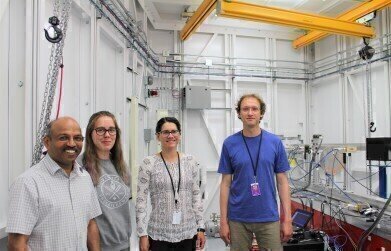-
.jpg) Arseniosiderite Specimen BM.62813 from the collections of the Natural History Museum, London (Credit The Trustees of the Natural History Museum, London.
Arseniosiderite Specimen BM.62813 from the collections of the Natural History Museum, London (Credit The Trustees of the Natural History Museum, London. -
 Pictured: Narayan Appathurai, Chelsea-Lea Randall, Beatriz Moreno, and Graham King at the beamline (Credit: CLS)
Pictured: Narayan Appathurai, Chelsea-Lea Randall, Beatriz Moreno, and Graham King at the beamline (Credit: CLS)
News
International Project reveals Structures of Arsenic Compounds
Jan 19 2021
International researchers have used the Canadian Light Source at the University of Saskatchewan to uncover the structure of two arsenic-containing compounds yukonite and arseniosiderite - information that can be used to prevent and predict arsenic contamination in soil sources that might affect waterways.
Discovered more than 100 years ago, the structure of yukonite and arseniosiderite have been difficult to determine because of their low crystallinity; now using a special technique at the CLS, an international team of researchers from Canada, China, the USA, Italy and Ireland was able to visualize for the first time how atoms are structured in samples of arseniosiderite and yukonite.
For McGill University graduate Mario Alberto Gomez, one of the project’s leads, it’s appropriate the discovery was made using the first Canadian beamline capable of doing this type of analysis. “I think it was quite fitting that this mineral (yukonite) was discovered in Canada, in the Yukon, a long time ago and then we were doing research on it. And now we were able to finally get a clearer picture of it using a Canadian synchrotron.”
Originally from Canada but currently a visiting professor at China’s Shenyang University of Chemical Technology, Gomez draws parallels between his team’s findings and how knowing the structure of the COVID-19 coronavirus helps scientists understand how it functions, which in turn enables drug companies to develop vaccines.
For example, other natural and lab-based studies have shown that when yukonite and arseniosiderite are placed in a solution containing calcium, they release less arsenic. “Knowing their structure now will help us better understand why this happens,” he added.
For further information on CLS visit www.lightsource.ca
Published in Environmental Science Nano.
Digital Edition
Lab Asia Dec 2025
December 2025
Chromatography Articles- Cutting-edge sample preparation tools help laboratories to stay ahead of the curveMass Spectrometry & Spectroscopy Articles- Unlocking the complexity of metabolomics: Pushi...
View all digital editions
Events
Jan 21 2026 Tokyo, Japan
Jan 28 2026 Tokyo, Japan
Jan 29 2026 New Delhi, India
Feb 07 2026 Boston, MA, USA
Asia Pharma Expo/Asia Lab Expo
Feb 12 2026 Dhaka, Bangladesh


















